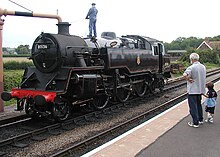2-6-4
Neilson, Reid & Company | |
| Evolved from | 2-6-2 |
|---|---|
Under the
Overview
With only a few known exceptions, the Adriatic wheel arrangement was usually used on tank locomotives, for which various suffixes to indicate the type of tank would be added to the wheel arrangement, for example 2-6-4T for an engine with side-tanks.
Tender locomotives
The earliest known example was the South African Class 6Z, designed by Cape Government Railways (CGR) Chief Locomotive Superintendent Hazlitt Beatty in 1901. The first engines of the class were modified 2-6-2 Prairie locomotives which were equipped with two-axle trailing bogies. In 1902, more were placed in service, but built with the 2-6-4 wheel arrangement. The latter were the first known tender locomotives in the world to be built with this wheel arrangement.[1][2][3]
Tank locomotives
Usage
Austria

Two Austrian express tender locomotive types were of this wheel arrangement, the Class 210 of 1908 and Class 310 of 1911 designed by Karl Gölsdorf. The type therefore became known as the Adriatic arrangement, named for the Adriatic Sea which bordered Austria-Hungary until 1918.
Brazil
Preserved meter gauge locomotive Dona Joaninha, built to haul sugar cane in Brazil, uses the 2-6-4 wheel arrangement.
Finland
Finland had three locomotive classes with a 2-6-4T wheel arrangement, the Classes Vk1, Vk2 and Vk3. All three classes were nicknamed Iita.
The Class Vk1, numbered 301 to 305, were delivered in 1900 from Baldwin Locomotive Works of Philadelphia, Pennsylvania. The Class Vk1 Iita were also nicknamed Amerikan because they were built in the United States of America.
The Class Vk2 were numbered 454 to 455.
The
Germany

For the private TAG, which operated the railway line from Schaftlach to Tegernsee, the 2-6-4T steam locomotive TAG 8 was built in 1942, using wheels from DRG Class E 79. It was in service until 1970 and has been preserved in the Bavarian Railway Museum.
Sweden
SJ type SB with driving wheels 1.75 m diameter for passenger use, built Motala 1917, one preserved.
SJ type J with driving wheels 1.3 m diameter for mixed traffic use, built Atlas, Motala and Nohab, 1914–1918. Four preserved.
Switzerland
2-6-4 tank locomotives were built by SLM in 1913 for use on the Berne-Neuenberg railway. They were still in use at Basel in 1956. Of slightly British appearance, at that time they were used to transfer stock between the French and Swiss systems, the former having not yet been electrified.
New Zealand
The Ferrymead Railway in Christchurch, New Zealand has a 3 ft 6 in (1,067 mm) gauge 2-6-4T locomotive that was in regular operation until taken off-line for boiler repairs around 2009. It was built by Baldwin Locomotive Works in 1901.[6]
The
- Wf386, one of the engines used on the first Wellington to Auckland train, is preserved at Paekakariki.
- Wf392 was sold to the Tasmanian Government Railways and used as a Ds class locomotive. Its boiler is on display at Don River Railway
- Wf393 is preserved at Ferrymead Railway.
- Wf403 is preserved at Nelson Railway Society.
South Africa
Between 1898 and 1900, the Pretoria-Pietersburg Railway (PPR) placed six 2-6-4T locomotives in service, built by
In 1901, the CGR placed four 6th Class

In 1902, the CGR placed two
United Kingdom
The first British examples of the 2-6-4T wheel arrangement were two locomotives built for the narrow-gauge

Between 1927 and 1947, the London, Midland and Scottish Railway (LMS) built nearly five hundred 2-6-4Ts for suburban passenger work to four similar designs (see LMS/BR Class 4 2-6-4T locomotives). The last of these, the LMS Fairburn, continued to be built by British Railways (BR) until 1951. Fairburn's LMS design also formed the basis of the very successful BR Standard Class 4, which continued to be produced until 1957.

Between 1946 and 1950, George Ivatt of the LMS also built eighteen 5 ft 3 in (1,600 mm) examples of a very similar design at Derby Works, for use in Northern Ireland. These later became the Northern Counties Committee WT class.
A prototype of the London and North Eastern Railway (LNER) L1 class, designed by Edward Thompson, was built in 1945. The remaining 99 members of the class were built under British Railways administration during the period from 1948 to 1950.
United States
The Reading Company used 2-6-4T Adriatics for commuter service.
Model railroading
The Lionel Corporation used the 2-6-4 wheel arrangement in many of its model steam locomotives, including the 2037 used in the infamous Girls' Train.[9]
References
- ^ ISBN 0715386387.
- ^ a b Neilson, Reid works list, compiled by Austrian locomotive historian Bernhard Schmeiser
- ^ ISBN 978-0-7153-5382-0.
- ^ ISBN 978-0-7153-5427-8.
- ^ ISBN 0869772112.
- ISBN 0-908876-99-8.
- ^ a b Classification of S.A.R. Engines with Renumbering Lists, issued by the Chief Mechanical Engineer’s Office, Pretoria, January 1912, pp. 7, 11, 13, 19 (Reprinted in April 1987 by SATS Museum, R.3125-6/9/11-1000)
- ISBN 0-7110-1151-6. DX/0582.
- ^ Tandem Associates - Lionel Locomotives
